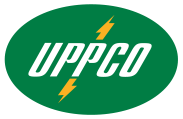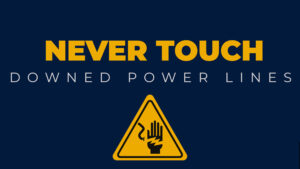Quick Links

Preparing for Emergencies
Stay informed & be prepared!
The Upper Peninsula has weather in all four seasons, which can cause power outages. Try to check weather forecasts so you’ll be prepared. A little advance preparation goes a long way!
Below is a checklist for building an emergency plan, along with a few resources where you can learn more.

Safety During Storms & Floods
Use the following information to keep your family safe during and after a storm.
Preparing for a Storm
Check out these 10 Tips for Building an Emergency Plan
During a Storm
Monitor TV and radio or public alert devices for important weather updates and news bulletins.
If you experience a power outage, call UPPCO at (906) 449-2011.
- If you anticipate an extended outage, consider moving yourself and your family — especially those with special needs — to an alternate location.
- Don’t open freezers and refrigerators more than absolutely necessary. Opening these appliances will allow food to thaw more quickly.
- Turn off as many appliances, electronics and light switches as possible. This will reduce the potential for damage when power is restored.
After a Storm
- If the storm leads to an outage, please be patient while we work to restore your power.
- Don’t try to cut or remove downed trees or branches unless you are absolutely certain power lines are not involved. A licensed tree removal company may be a better option.
- Replenish your supplies of batteries, bottled water and non-perishable food items. Test storm equipment regularly.
- Have a licensed electrician disconnect your generator unless the generator has an automatic disconnection device.
Downed Power Lines
- If you see a downed power line, call UPPCO at (906) 449-2011.
- Consider all downed power lines and anything touching them as energized and DANGEROUS! KEEP EVERYONE AT LEAST 35 FEET AWAY and immediately report the problem to UPPCO.
- If a power line falls across a car that you’re in, stay in the car and call 911. If you MUST get out of the car due to a fire, or other immediate danger, jump clear of the car, stop touching the car and land on both feet. Be sure that no part of your body is touching the car when your feet touch the ground.

Generator Safety
Using a Generator:
There are several ways to connect your generator to your home’s wiring circuit. However, the generator must be electrically isolated from UPPCO’s distribution system.
-
- A double-throw transfer switch, or similarly approved isolation switch, must be installed to isolate the generator from UPPCO’s distribution system.
- Be sure to obtain the proper electric permits and have your installations inspected.
- The double-throw or throw over switch may be manually or automatically operated. Customer-owned generating equipment shall not operate in parallel with the Company’s system except under specific contract with the Company covering the conditions of such operation.
- Never operate a generator in your home, garage, basement or any other enclosed area.
- A generator should be at least four (4) feet from enclosed areas, doors, windows, and fresh air intakes where exhaust fumes and carbon monoxide can enter the home. Proper ventilation is critical.
- A temporary canopy can be constructed over the portable generator to keep it dry. Leave adequate room for proper ventilation.
- Always read the owner’s manual carefully following all manufacturer instructions and precautions before starting and operating your generator.
- Overloading your generator can cause damage to the generator and any connected appliance or component.
- By alternating your appliances, you can stay within your portable generator’s output.
- Start your generator before connecting appliances or equipment.
- Before shutting down your generator, turn off connected equipment.
- Most refrigerators and freezers are good for about 24 hours if the door is not opened. Beyond that, four to six hours of run time on a generator is usually adequate per day.
- Never plug a portable generator into a wall outlet; you could damage your home’s wiring
- When using a portable generator, connect appliances to the generator using flexible extension cords with current ratings adequate for the appliances being served.
- A double-throw transfer switch is not required when a portable generator serves appliances via a properly rated extension cord, i.e., refrigerators, freezers, space heaters, etc.
Installing a Permanent Generator: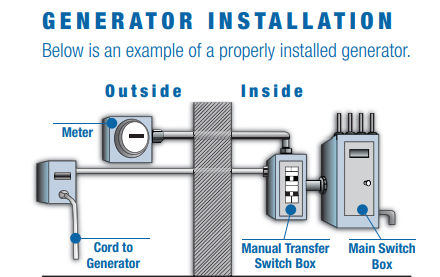
If you are installing a permanent standby generator system, consult an expert. Potential problems in addition to the need for a transfer switch include:
- Ground Fault Interrupters (GFI’s) are installed on most portable generators.
- Some generators are rated to only supply 240 volt or 120 volt loads and not both at the same time (120 / 240 rating-center tapped).
Care also needs to be taken in sizing generators. Normally, generators must be oversized to handle the in-rush of a starting motor. A generator would also need to be oversized if there is going to be a lot of electronic load on it. A speci
al concern with electronic loads is the operation of the generator as it runs out of fuel. The internal voltage regulation may not be able to protect electronic equipment connected to the generator.

Basic Electrical Safety
Every home or business appliance, electronic item, furnace or water heater has specific product safety guidelines. We encourage you to check published and authorized owner’s manuals and on-line resources for any household appliance or electrical device.
There are some common-sense electrical safety tips that everyone in your household should learn:
- Stay away from meters, electrical boxes and utility poles.
- Never put anything but an electrical plug into a wall socket.
- Don’t overload the socket — one socket, one plug.
- Never pull a plug out by the cord.
- Make sure there are no holes or breaks in extension cords.
- Never put extension cords under carpets or rugs.
- Put plastic covers on unused outlets to protect small children.
- Dry your hands before using any electrical appliance, switch or plug.
- Keep small appliances away from bathtubs or showers.
- Never use your oven or stove to heat your home.
- Keep an all-purpose fire extinguisher on each floor of your home.
- Follow a space heater’s instructions carefully.

Power Line Safety
Power lines carry a lot of electricity and can be dangerous. Here are some important reminders to stay safe near power lines.
Downed Lines
- If you see a downed power line, call UPPCO at (906) 449-2011.
- Never touch a downed power line, even if you don’t see sparks.
- If someone is touching a downed power line, do not touch that person.
- If you come across a car that has hit a utility pole, stay away; it may have a downed power line on it.
- If you are inside a car that has a downed line on it, call 911 and stay put until help arrives.
- If you have to leave the car for emergency reasons — such as a fire — jump out with both feet together, being certain to NEVER touch the car and the ground at the same time.
Overhead Lines
- Never touch overhead power lines with your hand or any object.
- Don’t let anyone climb trees or fly kites near overhead power lines.
- High snow piles can get close to overhead lines. Be careful in winter.

Tree Trimming Safety
ATTENTION:
If you have a tree that has grown into or has fallen onto power lines, stay away and call UPPCO at (906) 449-2013. A tree limb in contact with an electric line is extremely dangerous and life-threatening.
UPPCO Regular Tree Maintenance:
Providing you with safe and reliable electricity is a priority at UPPCO. That's why we have a proactive tree trimming program. To prevent trees from growing into power line areas, we trim trees every six years in residential areas and every five, six, or eight years in rural areas.
Despite our hard work, trees and branches can still cause power outages, especially during storms.
If you have a tree that has grown into or has fallen onto power lines, stay away and call UPPCO: (906) 449-2013. A tree limb in contact with an electric line is extremely dangerous and life-threatening.
Vegetation Management
Trimming and planting guidelines.
Frequently Asked Questions
Answers to common questions about UPPCO tree trimming.
Safety Information, Education And Contact Information
More about Tree Line USA, the Arbor Day Foundation and contact information.
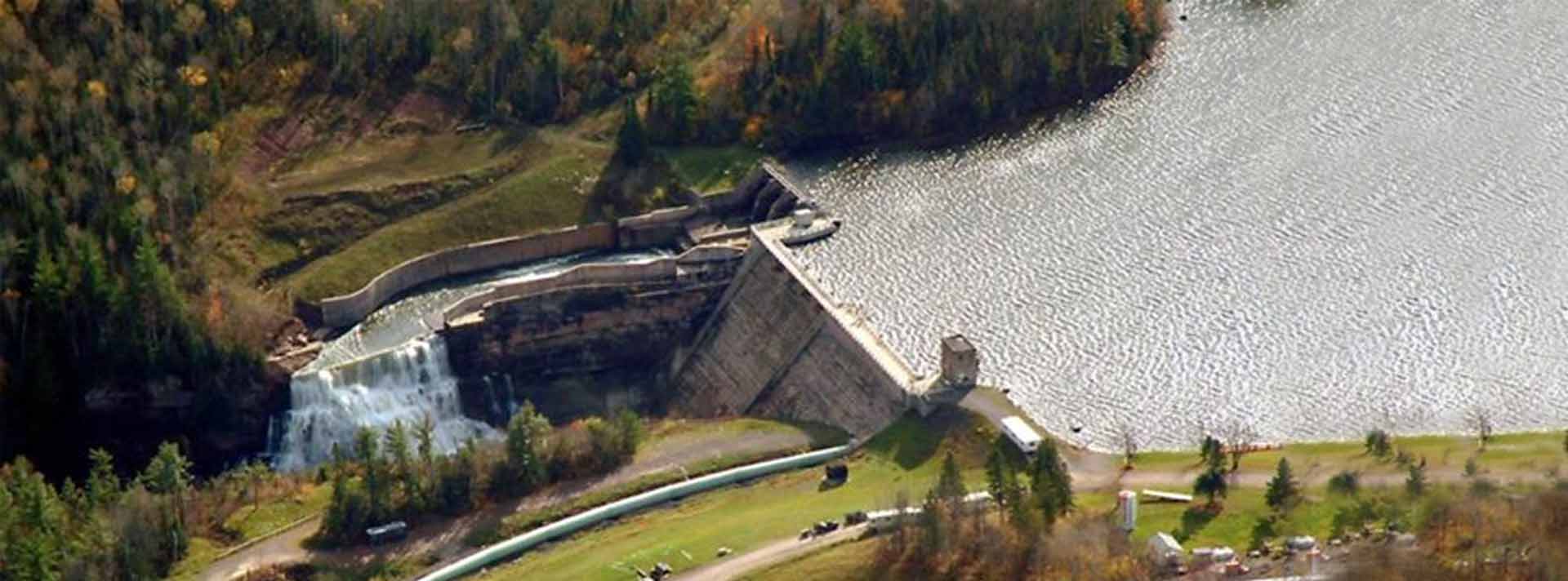
Dam Site & Flood Site Safety
Every year, people are seriously injured or killed at dams. Most of these accidents could be avoided by simply staying clear of the restricted zones at dams and by obeying all warning devices.
The following information is also available in a printable-brochure here: Upper Peninsula Power Company Dam Safety Brochure
Keep Your Distance From Dams - Stay Safe
- Always stay a safe distance away (at least 25 feet) from warning signs, buoys and barriers when fishing, boating or swimming.
- Stay away from the edge of waters above and below hydroelectric stations.
- Stay back from dry riverbeds below dams. They can quickly change into rapidly flowing waterways.
Be Alert For The Warning Signs Of Rising Water:
- Flashing lights, horns, or sirens.
- Increased or changed wildlife activity.
- Louder sound of rushing water.
- Previously exposed rocks or snags are covered with water.
- Clear water quickly becomes cloudy.
- Suddenly faster water currents.
- Never anchor a boat below a dam. Rapid surges in water levels can pull an anchored boat underwater in seconds.
- Beware of dangerous and unseen currents. Backrollers, eddies, and whirlpools can pull a boat upstream into a spillway and quickly capsize it.
- Boating above or below a dam can be very dangerous. Always maintain a safe distance from the dam.
- Keep your motor running when near a dam so that you are always ready to maneuver or leave the area quickly.
- Stay away from spillways. Changing currents and unpredictable waves make boat control difficult.
Flood Safety
Each year, more deaths occur due to flooding than from any other severe weather-related hazard. People often underestimate the force and power of water. More than half of all flood-related deaths result from vehicles being swept downstream. Of these, many are preventable.
Follow These Safety Rules:
- Monitor the NOAA Weather Radio All Hazards or your favorite news source for vital weather-related information.
- If flooding occurs, get to higher ground. Get out of areas subject to flooding. This includes dips, low spots, canyons, washes etc.
- Avoid areas already flooded, especially if the water is flowing fast. Do not attempt to cross flowing streams. Turn Around, Don’t Drown.
- Road beds may be washed out under flood waters. NEVER drive through flooded roadways. Turn Around, Don’t Drown.
- Do not camp or park your vehicle along streams and rivers, particularly during threatening conditions.
- Be especially cautious at night when it is harder to recognize flood dangers.
Critical Danger Zones At Dams
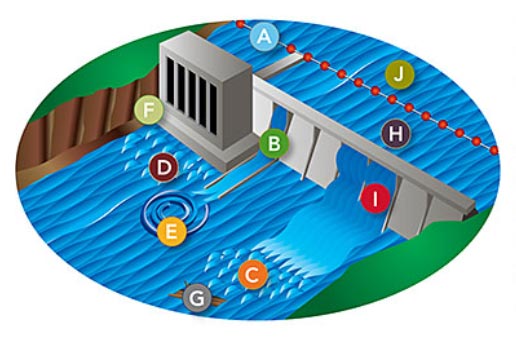
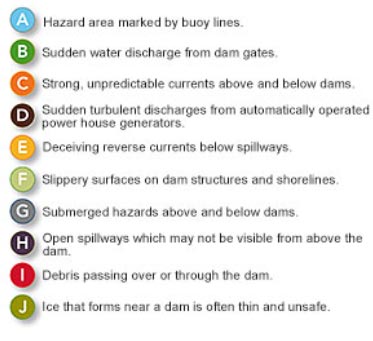

Digging Safety & Miss Dig
Call before you dig, it's the law
No matter where you live, the gas, electric, cable TV, water and sewer lines that serve you may be underground.
If you are planning a project that involves digging, state law requires you to notify MISS DIG at least three working days in advance.
MISS DIG is open 24 hours a day, 7 days a week, 365 days a year!
To notify of your intent to dig:
- Call 811 or
- Visit MISS DIG
Above-ground markers
You'll know what's below by the different color flags, stakes or paint. Identify these marks before you excavate. Red flags mark electric lines.

